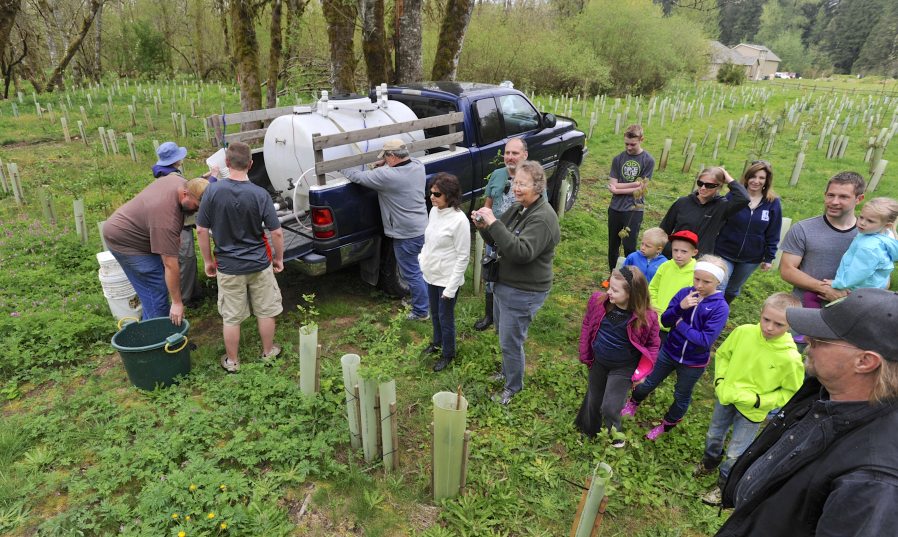BATTLE GROUND — Nine-year-old Maya Elwell was the first to tip her plastic bucket and slide about a dozen coho salmon into upper Salmon Creek on Saturday. Northwest Wild Fish Rescue released about 2,000 to 3,000 young salmon as part of their ongoing efforts to improve ailing wild fish runs in area waterways once busting with them.
“I think it’s very fun and it’s nice to see that the fish are happy in this little creek,” Maya said. Her family lives just on the other side of the creek, and she’s been learning about fish at school.
“They like to group together in migration,” she said.
Ed Miller stood in the creek in waders as people came to the water’s edge with buckets of fish, either smolt or pre-smolt.
“Tell them we’ll see them in two years,” he quipped.
Northwest Wild Fish Rescue is a one-of-a-kind operation that captures young coho salmon and steelhead from waterways where they would otherwise become stranded and die when the water drops or dries up. Dave Brown stores the fish and raises them in several pens on his property — fed by an elaborate system of pipes tapping natural spring water — before releasing them back into the Salmon Creek watershed when water is higher. This year, they’ve raised about 30,000 fish.
Saturday’s coho were captured in the Dollars Corner area, he said.
His group, along with several nearby residents, accessed upper Salmon Creek from Carl and Kristie Burger’s property near the intersection of Northeast Risto Road and 182nd Avenue east of Battle Ground. Carl Burger met Brown about 10 years ago through his work with the U.S. Fish and Wildlife Service.
“He does it right, and he’s really made a difference trying to protect wild fish,” Burger said. Burger nominated Brown for the Fishery Conservation Award, which he received last summer.
“We hope by doing what we’re doing we can rebuild these runs,” said volunteer Linda Conaway. If nothing is done, it’s possible for salmon to go extinct in this area, she said, turning this section of the Columbia into a “ghost river.”
The poor condition of Salmon Creek, overfishing and reliance on hatchery-raised fish has led to decreased salmon runs, Brown said. He said it’s important to release wild fish into Salmon Creek because they’re genetically stronger and more likely to survive the trek to the Pacific Ocean and back.
Spring chinook salmon angling in the lower Columbia River closed Saturday to avoid exceeding the catch allocation. According to the Washington Department of Fish and Wildlife, the lower Columbia sport fishery would have exceeded its allocation by 990 upper Columbia-Snake fish if angling had continued Saturday.
Trees help fish
The Burgers’ residence was one of many in the Bridlewood Meadows subdivision where Clark Public Utilities has done habitat restoration work. The newly planted trees will eventually provide cover for the fish that keeps their water cleaner and cooler.
Colder water has more oxygen, which fish need to survive.
“There’s going to be some nice runs here in five to 10 years,” said Jeff Whittler, who manages stream restoration projects for the utility.
Whittler said when the trees get older, some will eventually fall into the creek, creating habitat features that are the “lifeblood” of the creek. Improving the floodplain also improves the overall quality of drinking water in Clark County, which gets most of its water from the underground Troutdale Aquifer.
Floodplain restoration is seen as a longer-term solution to improving the creek and bolstering salmon runs.
Scott Satterlee, a volunteer with the fish rescue, lives nearby in the High Valley area south of Venersborg. There, the Clark Conservation District has plans to build a back channel this summer, he said.
The back channel, or side channel, gives fish a place to rest during high flood waters in the winter or low water in the summer.
A potential cover over the channel would offer the fish more protection from predators, mainly birds.




